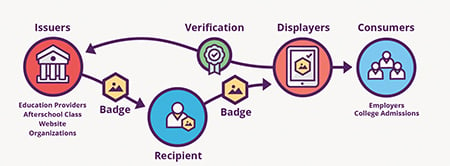Over the past year the BCS Learning & Development Specialist Group has been looking at whether digital badging is just a fad, or something that can add real value to an organisation’s learning culture.
Digital badging workshop
In October 2017, the BCS Learning & Development Specialist Group brought together a panel of experts from Pearson VUE (providers of the Acclaim badging platform), Questionmark and DigitalMe (who use the Credly platform) and CompTIA, together with the vendor training director’s organisation CEdMA Europe, to discuss the current state of digital badging and whether it can really address the need to create a viable professional recognition approach for the IT industry.
The workshop learnt that the essence of digital badging is to provide learners with credentials that are ‘resumé-worthy,’ and become an important part of someone’s permanent profile. Digital badges are credentials that symbolise learning achievements at any level - knowledge, skills, certificates, diplomas, certifications or licences.
Each badge contains a set of metadata defined by the issuer about the skills being recognised, and the accomplishments achieved. The common structure of a digital badge allows learners the interoperability, transparency and verification that they need to validate their learning achievements - important qualities for 21st century learning credentials. Each badge issued represents what you know and what you can do, which organisation is backing your claim, and how you earned this recognition.
The Mozilla Foundation created the first Open Badges in 2011 as a new way to recognise learning wherever it happened. They set out a standard which is now seeing a new badge issued every four seconds. About two-thirds of those badges are being accepted and shared by learners. Although Open Badges are issued by organisations, it is important to note that learners must find them valuable enough to claim and share them.
Many Open Badges go unclaimed because they don’t recognise achievements that the learners find persistently valuable, or resumé-worthy, so the ‘share’ statistic is an important measure of the value of individual badges - and indeed of the overall approach.
One of the providers at the workshop reported that credentials on their platform are shared more than 5,000 times per day, generating millions of valuable brand impressions and leads for credential issuing organisations.
Questionmark highlighted that we are still in the early-adopter phase of digital badging, and that, as learners and the industry become more familiar with the concept of digital credentials, adoption should increase. The challenge now is to help learners and issuers move from the world of the paper certificate, which is well understood, and can be put on your office wall and cannot be taken away once granted.
Paper-based credentials used to be hard to forge but forging is now relatively easy with digital printing. Digital credentials on the other hand are a newer concept and are real-time. They can have a duration and can be revoked, but, most importantly, the credentials can be verified with the badge issuer which makes forging much harder to achieve.
How Open Badges work
The Open Badge specification is made up of three types of badge objects: an assertion representing an awarded badge that contains information about a single badge, which belongs to an individual earner; the badge class that contains information about the accomplishment(s) a specific badge recognises; and the issuer organisation which contains a collection of information about the entity that issued the badge.
Beginning with version 1.1 of the Open Badge standard, the badge must be created using JSON-LD. This facilitates a standard format for collaboratively extending badge objects so that any issuer, earner, or consumer can understand the information added to badges. Any issuer may define and publish extensions to include new types of metadata in badges in a way that any other issuer may use the same extensions to publish similar information in a mutually recognisable form.

The Open Badges ecosystem
The above shows the ecosystem of a digital badge (Source: The Open Badges Ecosystem by Erik Knutson, Concentric Sky, licensed CC-BY). Once the badge has been created by a badge issuer using a badge platform, the badge is sent electronically to the recipient who is invited to ‘claim’ the badge. When they have done that they can use the URL for the badge to display it on social media, websites, or send it to consumer organisations such as employers or institutions.
At any point a consumer can verify the validity with the badge issuer to ensure it has not expired, together with the details about the issuing organisation, what the earner has done to achieve the badge, the assessment criteria, evidence that the badge was issued to the expected recipient, and any other unique detail that relates to the badge.
Uses of digital badges
Digital badges can help provide richer learning programmes in commercial, academic and workplace environments. For commercial providers, digital badges can help organisations improve their existing certification programmes through a reduction in false credentials, as there is a direct link between the learner and the badge issuer.
For badge issuers, digital badging allows them to introduce micro-credentials, or progression badges. These can increase the take-up of high-stakes certifications by offering a sequence of steps that learners can follow in order to achieve milestone badges.
There is also the benefit to issuers of additional revenue from the micro-credentials, and the potential to issue delta badges to keep credentials current when, for example, a new version of software is released.
In the academic world, badges can be issued by module, to enable learners to show the make-up of their degree, and demonstrate achievement at key stages throughout their studies. It also allows employers to offer skills-based courses that offer badges that give academic credit for formal training taken outside of a traditional degree programme. In the workplace, digital badges can be used to provide recognition of eLearning or observational learning.
More importantly, badges can make competency models real and motivate staff to increase their skills, as digital badges can provide clear steps for learning pathways linking staff to their next professional development activity. Badges are also very attractive to millennials who want to showcase their achievements to secure salary increases and promotion.
Future of digital badging
Without doubt, digital badging represents the way forward for the recognition of skills in the same way as a CV does today. However, the lack of a common skills definition framework will lead to challenges with being able to compare achievement across badge issuing organisations. A competency framework such as SFIAplus could be of significant value to digital badging going forward.
Other challenges faced by badge issuers are the need to ensure credibility of badges through aligning and differentiating badges and certifications, driving transparency around the underlying evaluation criteria for badges, ensuring a strong ‘currency’ of credentials to job and learning opportunities to enable an increasingly personalised and continuous learning experience.
The conclusion drawn from the events that the group have run is that digital credentialing does in fact have the potential to be the ‘great leap forward’ in the learning and assessment space and could drive a true paradigm shift, but the challenges, such as possible dilution of validity and credibility, need to be taken into careful consideration when embarking on a digital credentialing approach.












